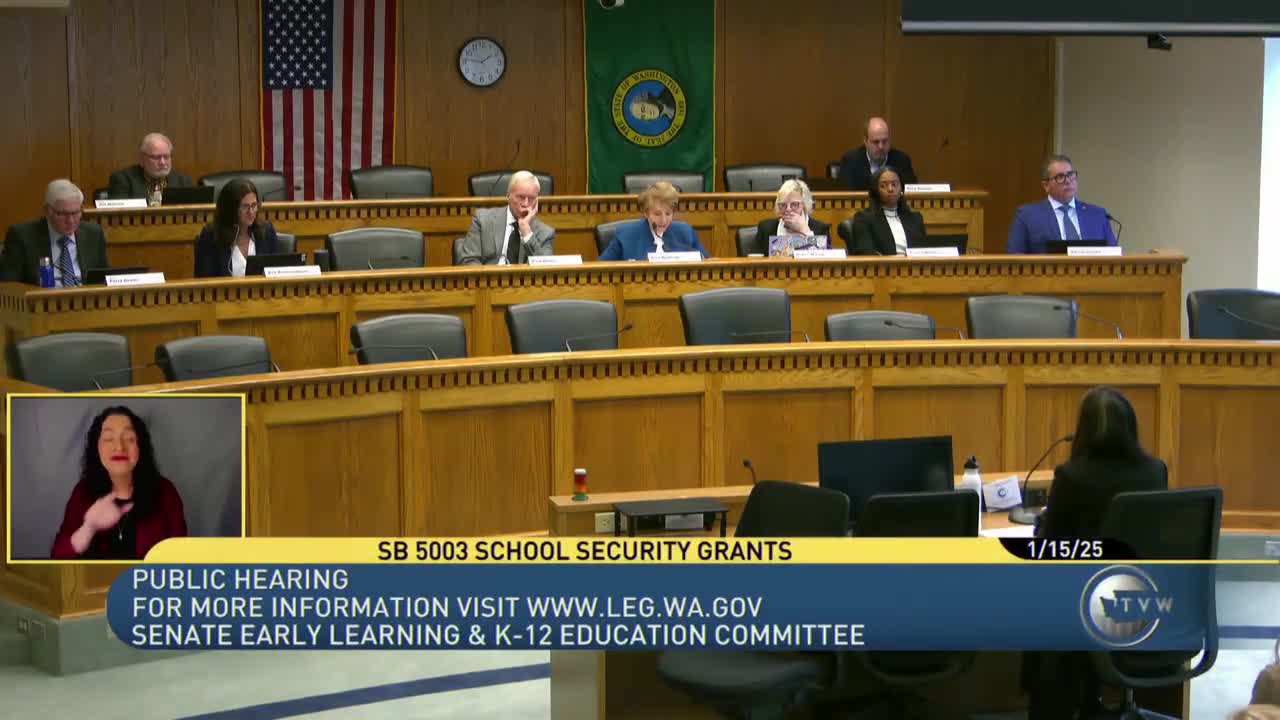Committee hears bill adding panic buttons and other tech to school emergency response options
January 15, 2025 | Early Learning & K-12 Education, Senate, Legislative Sessions, Washington
This article was created by AI summarizing key points discussed. AI makes mistakes, so for full details and context, please refer to the video of the full meeting. Please report any errors so we can fix them. Report an error »

Senate Bill 5004, presented to the Early Learning & K–12 Education Committee, would amend the definition of school emergency response systems to explicitly include panic or alert buttons, live video or audio feeds, remote control access to doors, live two‑way communications, and interconnection with an alert system maintained by the Washington Association of Sheriffs and Police Chiefs.
Committee staff summarized current law: school districts must work with law enforcement to develop emergency response systems using evolving technology. SB 5004 would require districts to submit a progress report on emergency response system implementation on Oct. 1 of the current year; OSPI would compile district reports and report to the Legislature on system types. The bill extends the requirement to charter schools and state‑tribal compact schools. Staff said a fiscal note had been requested but was not yet available.
Multiple in‑person and remote witnesses testified in favor. Lori Alhadeff, founder of Make Our Schools Safe and mother of a 2018 mass‑shooting victim, testified in support of Alyssa's Law—the wearable panic technology concept that directly links staff to law enforcement. Sarah Cordova, Yakima School District safety and security director, described the district's experience with Syntegix wearable badges, including a case in which the badge reportedly enabled rapid response to a staff medical emergency. Several other witnesses described improved response times in active threats and non‑threat emergencies when staff used wearable alert technology or when administrators could receive live audio or video feeds.
Senators and committee members discussed whether the bill created a new mandate or required funding; Senator Torres said the bill "does not change any existing law" and gives districts another option rather than imposing a mandate. Staff and witnesses noted that many districts already operate some of the covered technologies and that the bill formalizes reporting and gives districts the option to include new technologies in required emergency response plans.
No formal vote took place during the hearing.
Committee staff summarized current law: school districts must work with law enforcement to develop emergency response systems using evolving technology. SB 5004 would require districts to submit a progress report on emergency response system implementation on Oct. 1 of the current year; OSPI would compile district reports and report to the Legislature on system types. The bill extends the requirement to charter schools and state‑tribal compact schools. Staff said a fiscal note had been requested but was not yet available.
Multiple in‑person and remote witnesses testified in favor. Lori Alhadeff, founder of Make Our Schools Safe and mother of a 2018 mass‑shooting victim, testified in support of Alyssa's Law—the wearable panic technology concept that directly links staff to law enforcement. Sarah Cordova, Yakima School District safety and security director, described the district's experience with Syntegix wearable badges, including a case in which the badge reportedly enabled rapid response to a staff medical emergency. Several other witnesses described improved response times in active threats and non‑threat emergencies when staff used wearable alert technology or when administrators could receive live audio or video feeds.
Senators and committee members discussed whether the bill created a new mandate or required funding; Senator Torres said the bill "does not change any existing law" and gives districts another option rather than imposing a mandate. Staff and witnesses noted that many districts already operate some of the covered technologies and that the bill formalizes reporting and gives districts the option to include new technologies in required emergency response plans.
No formal vote took place during the hearing.
View full meeting
This article is based on a recent meeting—watch the full video and explore the complete transcript for deeper insights into the discussion.
View full meeting
